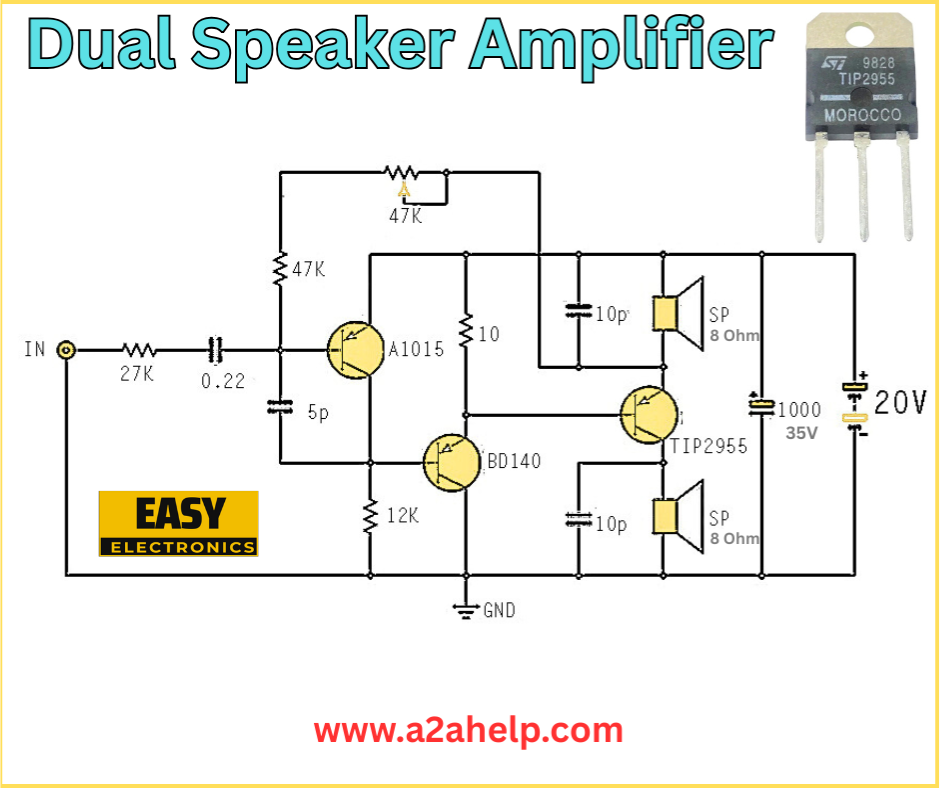Are you an electronics enthusiast eager to enhance your audio experience with a DIY project? The Dual Speaker Amplifier circuit using the TIP2955 transistor is a fantastic choice for beginners and hobbyists. This guide will walk you through the components, circuit analysis, assembly steps, and tips to build your own amplifier. Let’s get started!
What is a Dual Speaker Amplifier?
A dual speaker amplifier is designed to drive two speakers simultaneously, delivering stereo or dual-channel audio output. This particular circuit uses the TIP2955 PNP power transistor, paired with other components, to amplify audio signals effectively. It’s ideal for small audio systems, DIY speakers, or learning about amplifier design.
Components Required
To construct this dual speaker amplifier, you’ll need the following:
- TIP2955 Transistor: A PNP power transistor for amplification.
- A1015 Transistor: An NPN transistor for pre-amplification.
- BD140 Transistor: A PNP transistor for driver stage.
- Resistors: 27kΩ (2), 47kΩ, 12kΩ, 0.22Ω.
- Capacitors: 5pF, 10pF (2).
- Speakers: Two 8Ω speakers (SP).
- Power Supply: 20V to 35V DC (e.g., a 24V adapter).
- Ground (GND): Common ground connection.
Circuit Diagram Analysis
The schematic is simple yet effective. Here’s a breakdown:

- Input Stage: The audio signal enters through a 27kΩ resistor and is pre-amplified by the A1015 transistor, with a 5pF capacitor for stability.
- Driver Stage: The BD140 transistor amplifies the signal further, supported by a 12kΩ resistor and a 10pF capacitor.
- Output Stage: The TIP2955 transistor drives the two 8Ω speakers, with a 0.22Ω resistor and another 10pF capacitor ensuring proper current distribution.
- Power Supply: A 20V to 35V DC supply powers the circuit, with 47kΩ resistor setting the bias.
Step-by-Step Assembly Guide
- Prepare Your Tools: Gather a soldering iron, solder, wire cutters, and a breadboard or PCB.
- Mount the Transistors: Place the TIP2955, A1015, and BD140 transistors on the circuit board, ensuring correct pin orientation.
- Solder Resistors: Connect the 27kΩ, 47kΩ, 12kΩ, and 0.22Ω resistors according to the schematic.
- Add Capacitors: Solder the 5pF and 10pF (2) capacitors to their designated spots.
- Connect the Speakers: Attach the two 8Ω speakers to the output terminals.
- Wire the Power Supply: Connect a 20V to 35V DC supply, ensuring a solid ground connection.
- Test the Circuit: Input an audio signal (e.g., from a phone) and power on. Adjust the volume and check for sound from both speakers.
Tips for Success
- Power Supply: Use a regulated power supply within the 20V-35V range to avoid damaging components.
- Speaker Matching: Ensure both speakers are 8Ω to maintain balanced output.
- Heat Management: The TIP2955 may heat up; consider adding a small heat sink if used for extended periods.
Applications of a Dual Speaker Amplifier
- Enhance small home audio setups.
- Create a stereo system for personal use.
- Educational projects to understand amplifier circuits.
Troubleshooting Common Issues
- No Sound: Verify power supply connections and transistor orientation.
- Uneven Output: Check speaker wiring and ensure equal impedance.
- Distortion: Reduce input volume or check for loose connections.
Conclusion
Building a dual speaker amplifier with the TIP2955 is a rewarding DIY project that boosts your audio setup. Follow this guide to assemble your circuit and enjoy stereo sound. Visit www.a2ahelp.com for more electronics tutorials and projects. Start your build today!
